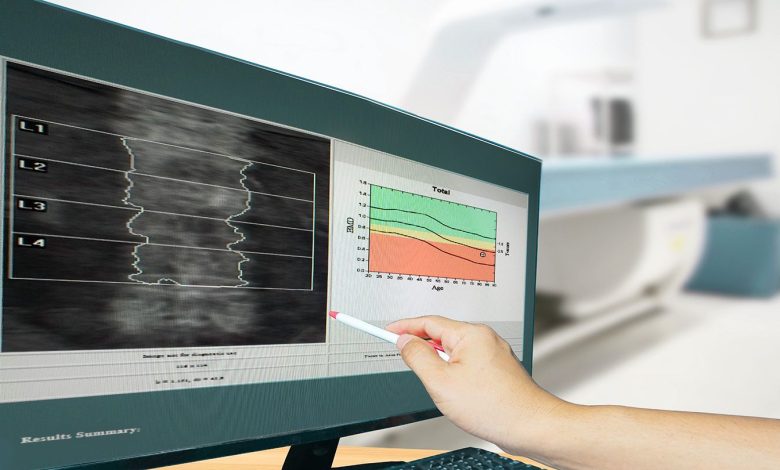What Is It Like to Get a Bone Mineral Density Scan

[ad_1]
The bone disease osteoporosis is a common condition in the United States, affecting almost 20 percent of women and 5 percent of men over age 50, according to the Centers for Disease Control and Prevention.
Osteoporosis occurs because bones are weakened by the hormone shifts of age, medications, or other factors. In the same way that a building relies on steel scaffolding to keep it strong, the body relies on the internal scaffolding of its bones. Our bone scaffolding is primarily built at a young age. As we get older — and especially after a woman goes through the hormonal transition of menopause — bones lose strength. When they get weak enough, they may break.
The diagnosis and treatment for osteoporosis should happen well before a breakage, says Ira Khanna, MD, assistant professor of rheumatology at Mount Sinai West in New York City. The best case scenario is to catch the disease well before discernible symptoms appear in order to treat it most effectively, she notes.
Bone mineral density (BMD) screening is the key way osteoporosis and its precursor, osteopenia, are detected. “Results from a bone mineral density scan provide a good indication of bone strength. It is the gold standard,” Dr. Khanna says.
If the disease is detected or if your bones are found to have lower than optimal mass at this screen, lifestyle changes and medication can be employed to keep bones as strong as possible.
What Is a Bone Mineral Density Scan?
The device most commonly used to screen for osteoporosis is a type of low level X-ray, known as dual-energy X-ray absorptiometry, or DXA (pronounced “dexa”).
The test requires a prescription from a healthcare provider. Because of the specialized machine required, it is generally performed in a radiology center or hospital.
Results from the test are read by a radiologist, who then consults with your regular healthcare provider to determine the best course of treatment.
Do I Need a Bone Density Scan?
The U.S. Preventive Services Task Force currently recommends that women get screened for bone health when they are 65 or older. (There is not enough evidence to recommend screening for men.)
Postmenopausal women who are younger than 65 should also be screened if they are at increased risk, the task force says. Factors increasing risk include a family history of the disease, going through early menopause, excessive alcohol drinking, current smoking, and using certain medications, including the steroids often used for autoimmune diseases and the aromatase inhibitors that treat cancer.
“Women and their clinicians should be aware of the risk factors for low bone density and the need to screen those with risk factors earlier than the recommended 65 years,” says Stephanie Faubion, MD, the director of the Mayo Clinic’s Center for Women’s Health and the medical director of the North American Menopause Society.
An online calculator known as a FRAX Risk Assessment tool can determine if you have an increased risk, along with a consultation with your physician.
Screenings are recommended every two years after the initial visit, Khanna says. People who are put on osteoporosis medication may need to be screened more frequently to see whether the drugs are working.
What Are the Benefits of Taking a Bone Density Scan?
BMD scans have long been proven safe and cost effective, researchers stated in a review of the method published in the Journal of Nuclear Medicine in 2021.
One cost calculator estimates that, with health insurance, the fee is typically just your copay, generally $10 to $30. Medicare also covers the screening.
People without health insurance might spend $150 to $250, the website states.
But the cost of breaking a bone from osteoporosis is more than $30,000, according to an analysis published in the American Journal of Managed Care in 2020.
What a Bone Density Test Involves
Bone density scans don’t require preparation, and they are painless. You can usually wear your regular clothes unless it has metal hooks, zippers, or buckles that may interfere with the machine.
Unlike an enclosed MRI, a DXA scan involves an open X-ray table.
You simply lie on your back on the table for the 10 to 20 minutes the procedure takes, without moving. (Fidgeting can blur the images.) A large scanning arm slowly passes over parts of your body, generally the hip and lower spine. The arm projects a narrow beam of low-dose X-rays that is used to calculate the density of the bones.
Are There Risks to Taking a Bone Density Scan?
DXA screens involve “an extremely low radiation dose,” according to the Journal of Nuclear Medicine review.
People shouldn’t be concerned about the risk of radiation, according to Khanna. “It is less radiation than we get from natural background radiation walking around outside,” she notes.
How Are the Results Evaluated?
A bone density scan compares results with the bone density expected for a young healthy adult.
The difference between the two is expressed as a standard deviation (SD) score, known as a T-score.
Osteoporosis occurs when the T-score is -2.5 or lower. Scores of -1.0 and -2.5 are considered to be low bone mineral density, or osteopenia, which sometimes also requires treatment.
What Should You Do if Your T-Score Indicates Osteoporosis?
People whose T-score indicates significant bone loss should be treated with medication, Khanna advises. Some patients worry about side effects from the medicines, including the well-publicized but very rare risk of jaw bone damage called osteonecrosis.
“But when you talk about a risk-benefit analysis, the risk of not taking medication is more likely to severely impact your life and your mortality than the extremely rare risk of osteonecrosis,” she says.
There are several medicines used to treat the condition. You and your physician should discuss the options — which include bisphosphonates, hormone therapy and others — and determine which is best for you.
[ad_2]




